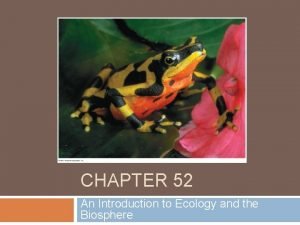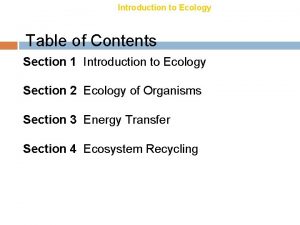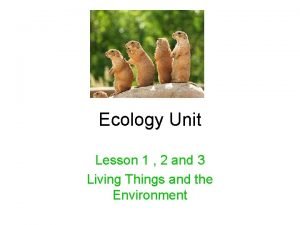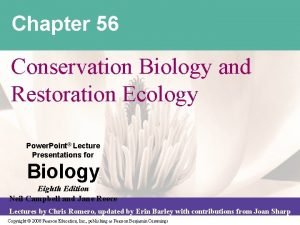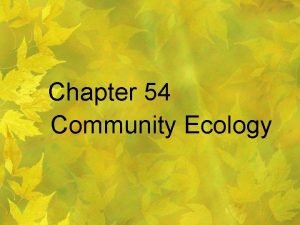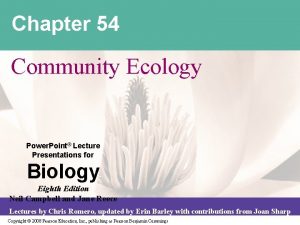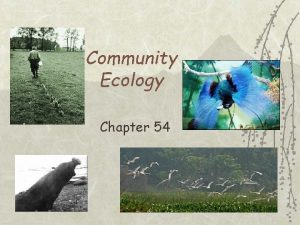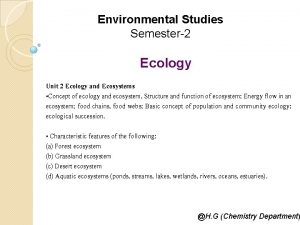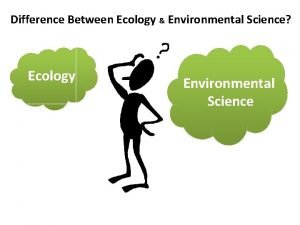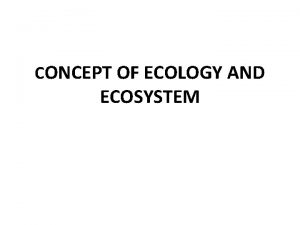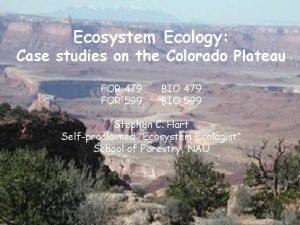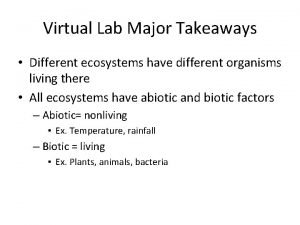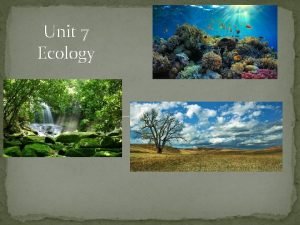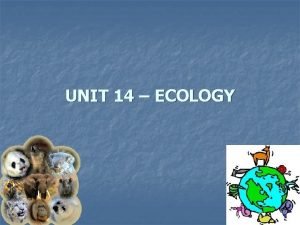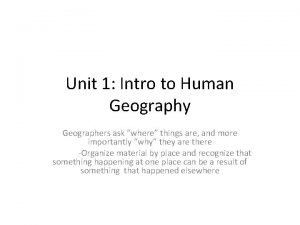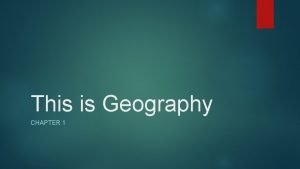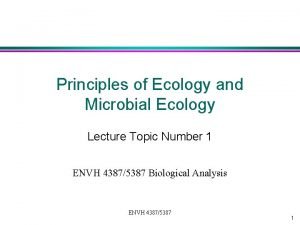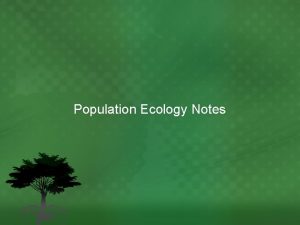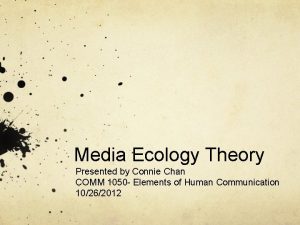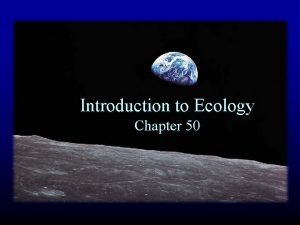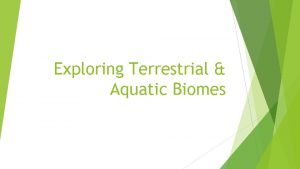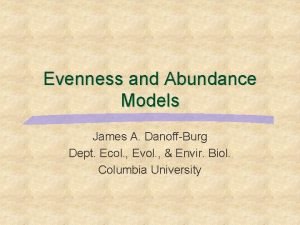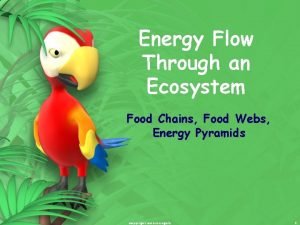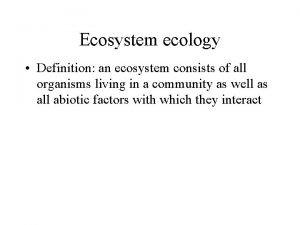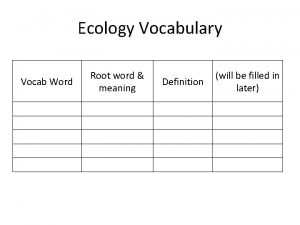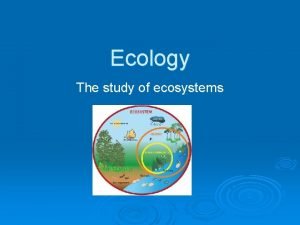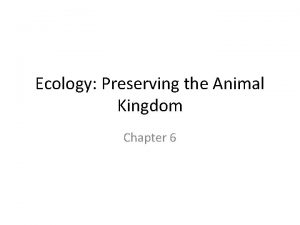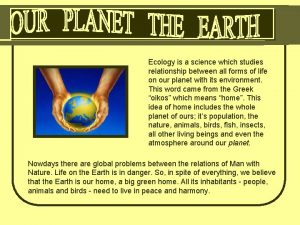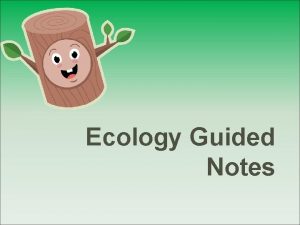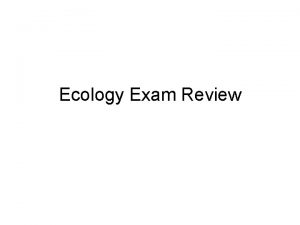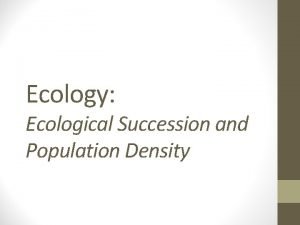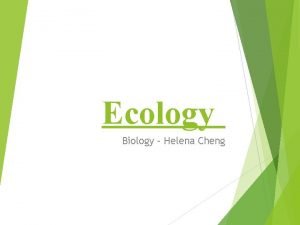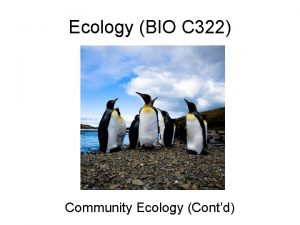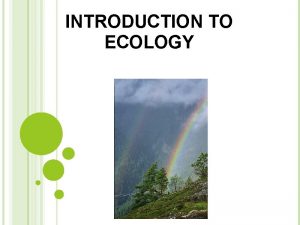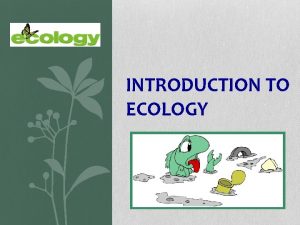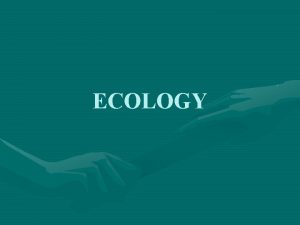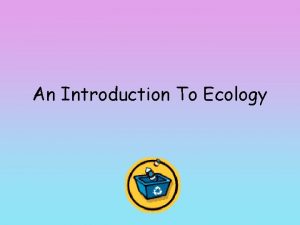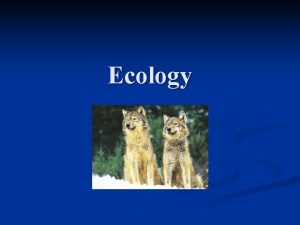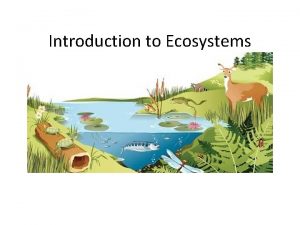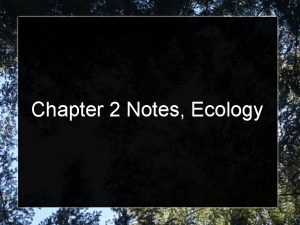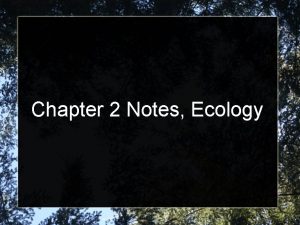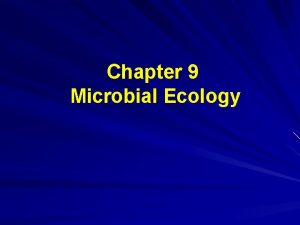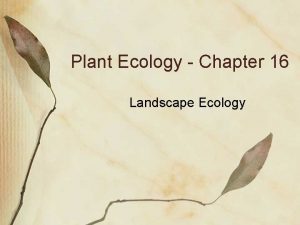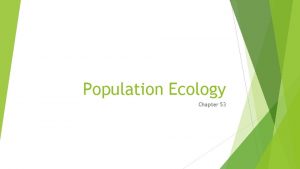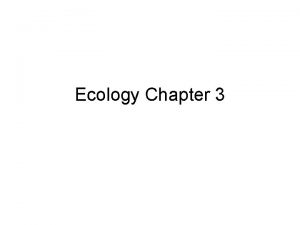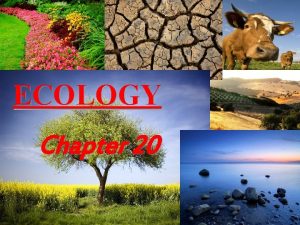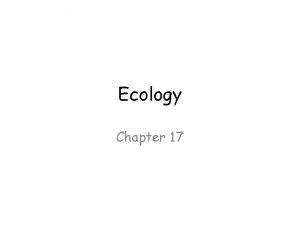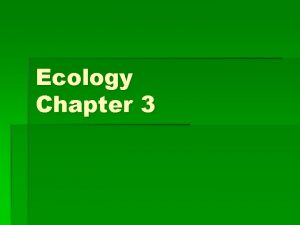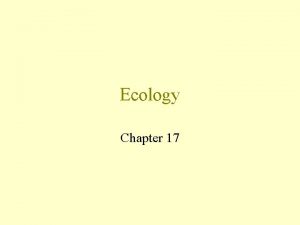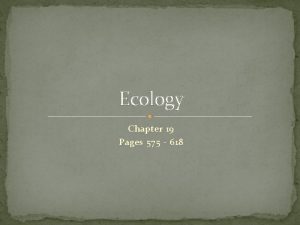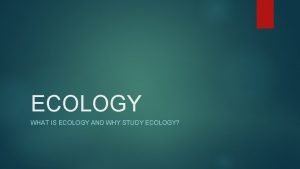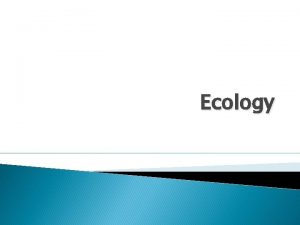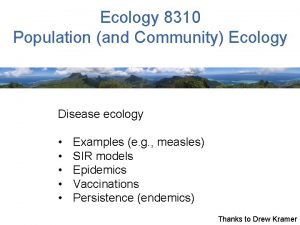7 Chapter 50 An Introduction to Ecology and



































































- Slides: 67

(7) Chapter 50 An Introduction to Ecology and the Biosphere (生態學及生物圈之介紹) Power. Point Lectures for Biology, Seventh Edition Neil Campbell and Jane Reece Lectures by Chris Romero Copyright © 2005 Pearson Education, Inc. publishing as Benjamin Cummings

Key Concepts(基本觀念) 50. 1: Ecology is the study of interactions between organisms and the environment. (生態學是研究生物與 環境間之互動) 50. 2: Interactions between organisms and the environment limit the distribution of species. (生物與環 境間之互動限制物種之分佈) 50. 3: Abiotic and biotic factors influence the structure and dynamics of aquatic biomes. (非生物與生物因子影 響水生生物之結構與動態) 50. 4: Climate largely determines the distribution and structure of terrestrial biomes. (氣候決定陸生生物之結 構與分佈) Copyright © 2005 Pearson Education, Inc. publishing as Benjamin Cummings

Overview: The Scope of Ecology (生態學的範 疇) • Overview: The Scope of Ecology • Ecology(生態學) – Is the scientific study of the interactions(互 動) between organisms and the environment • These interactions (互動) – Determine both the distribution(分佈) of organisms and their abundance(豐度) Copyright © 2005 Pearson Education, Inc. publishing as Benjamin Cummings

• Ecology (生態學) – Is an enormously complex and exciting area of biology. – Reveals the richness of the biosphere (生物 圈的豐富度). Figure 50. 1. The richness of the biosphere evident in one area of a Panamanian forest. Copyright © 2005 Pearson Education, Inc. publishing as Benjamin Cummings

• Concept 50. 1: Ecology is the study of interactions between organisms and the environment • Ecology (生態學) – Has a long history as a descriptive science( 描述性科學) – Is also a rigorous experimental science(實 驗性科學) – Is an integrative biology(整合性生物學). Copyright © 2005 Pearson Education, Inc. publishing as Benjamin Cummings

Organisms and the Environment (生物與環境) • The environment of any organism includes – Abiotic(非生物性), or nonliving components: temperature, sunlight, water and nutrient. – Biotic (生物性), or living components: other organisms. – All the organisms living in the environment, the biota (生物相) Copyright © 2005 Pearson Education, Inc. publishing as Benjamin Cummings

Ecology and Evolutionary Biology (演化生物學) • Events that occur in ecological time – Affect life on the scale of evolutionary time. Copyright © 2005 Pearson Education, Inc. publishing as Benjamin Cummings

Environmental components(環境成份、組成) Affect the distribution and abundance of organisms (影響生物的分佈與豐度). Kangaroos/km 2 Figure 50. 2. Distribution and abundance of the red kangaroo in Australia, based on aerial survey. > 20 10– 20 5– 10 1– 5 0. 1– 1 < 0. 1 Limits of distribution Southern Australia has cool, moist winters and warm, dry summers. Copyright © 2005 Pearson Education, Inc. publishing as Benjamin Cummings Climate in northern Australia is hot and wet, with seasonal drought. Red kangaroos occur in most semiarid and arid regions of the interior, where precipitation is relatively low and variable from year to year. Southeastern Australia has a wet, cool climate. Tasmania

Ecologists(生態學家) Scientist or biologist using observations (觀察) and experiments to test explanations (解釋) for the distribution (分佈) and abundance (豐度) of species. Copyright © 2005 Pearson Education, Inc. publishing as Benjamin Cummings

Four Subfields of Ecology (生態學之四個次領域 ) • Organismal ecology (個體生態學)---Studies how an organism’s structure, physiology, and (for animals) behavior meet the challenges posed by the environment. Figure 50. 3 a. Organismal ecology (個體生態學). How do humpback whales select their calving areas? Copyright © 2005 Pearson Education, Inc. publishing as Benjamin Cummings

Population ecology(族群生態學) Concentrates mainly on factors (因子) that affect how many individuals of a particular species live in an area. Figure 50. 3 b. Population ecology. What environmental factors affect the reproductive rate of deer mice? Copyright © 2005 Pearson Education, Inc. publishing as Benjamin Cummings

Community ecology (群聚生態學) Deals with the whole array of interacting species in a community. Figure 50. 3 c Community ecology. What factors influence the diversity of species (種的歧異度) that make up a particular forest? Copyright © 2005 Pearson Education, Inc. publishing as Benjamin Cummings

Ecosystem ecology (生態系生態學) Emphasizes energy flow (能量流) and chemical cycling (化學循環) among the various biotic and abiotic components (非生物 與生物組成). Figure 50. 3 d Ecosystem ecology. What factors control photosynthetic productivity in a temperate grassland ecosystem (草原生態系)? Copyright © 2005 Pearson Education, Inc. publishing as Benjamin Cummings

Landscape ecology(景觀生態學) Deals with arrays of ecosystems and how they are arranged in a geographic region(地理 位置). Figure 50. 3 e. Landscape ecology. To what extent do the trees lining the drainage channels in this landscape serve as corridors of dispersal forest animals? Copyright © 2005 Pearson Education, Inc. publishing as Benjamin Cummings

The biosphere (生物圈) -Is the global ecosystem, the sum of all the planet’s ecosystems. -The Earth is the Biosphere 1. (地球是生物圈一號) Copyright © 2005 Pearson Education, Inc. publishing as Benjamin Cummings


生物圈2號内各個组成部分及結構参數 區域 面積 (m 2) 體積 (m 3) 土壤 (m 3) 水分 (m 3) 大氣(m 3) 集約農業區 2000 38000 2720 60 35220 居住區 1000 11000 2 1 10997 熱帶雨林 2000 35000 6000 100 28900 熱帶草原/海洋/沼澤 2500 49000 4000 3400 41600 沙漠 1400 22000 400 17600 西肺 1800 15000 0 0 15000 南肺 1800 15750 0 750 15000 註: 上述两“肺”的體積僅為止其完全膨漲的50% Copyright © 2005 Pearson Education, Inc. publishing as Benjamin Cummings

Ecology and Environmental Issues • Ecology – Provides the scientific understanding underlying environmental issues • Rachel Carson – Is credited with starting the modern environmental movement. Figure 50. 4 Copyright © 2005 Pearson Education, Inc. publishing as Benjamin Cummings

Precautionary principle (預警原理/準則) • Most ecologists follow the precautionary principle regarding environmental issues. • The precautionary principle (預警原理/準則) – Basically states that humans need to be concerned with how their actions affect the environment. Copyright © 2005 Pearson Education, Inc. publishing as Benjamin Cummings

報告完畢 敬請指教 !? !? !? Copyright © 2005 Pearson Education, Inc. publishing as Benjamin Cummings

• Concept 50. 2: Interactions between organisms and the environment limit the distribution of species • Ecologists – Have long recognized global and regional patterns of distribution of organisms within the biosphere Copyright © 2005 Pearson Education, Inc. publishing as Benjamin Cummings

• Many naturalists (自然學家) – Began to identify broad patterns of distribution by naming biogeographic realms (生物地理範圍) 舊北極區 Palearctic 新北極區 Nearctic Tropic of Cancer (23. 5 N) 東方區 Oriental Ethiopian 衣索比亞區 Equator (23. 5 S) Tropic of Capricorn Neotropical 新熱帶區 Figure 50. 5 Copyright © 2005 Pearson Education, Inc. publishing as Benjamin Cummings Australian 澳大利亞區

• Biogeography (生物地理學) – Provides a good starting point for understanding what limits the geographic distribution of species Species absent because Area inaccessible Yes or insufficient time Yes Habitat selection Dispersal limits distribution? No Behavior limits distribution? No Predation, Water parasitism, Yes competition, Chemical. Oxygen factors Salinity disease Biotic factors p. H (other species) Abiotic factors Soil nutrients, limit No limit distribution? etc. distribution? Figure 50. 6 Copyright © 2005 Pearson Education, Inc. publishing as Benjamin Cummings Physical Temperature factors Light Soil structure Fire Moisture, etc.

Dispersal and Distribution (散佈與分佈) • Dispersal (散佈) – Is the movement of individuals (個體的移動) away from centers of high population density or from their area of origin – Contributes to the global distribution of organisms Copyright © 2005 Pearson Education, Inc. publishing as Benjamin Cummings

Natural Range Expansions Show the influence of dispersal on distribution. Figure 50. 7. Spread of breeding populations of the great-tailed grackle (長尾白頭翁) in the USA from 1974 to 1996. The grackle expanded its breeding range substantially in just 22 years. Copyright © 2005 Pearson Education, Inc. publishing as Benjamin Cummings New areas occupied Year 1996 1989 1974

Species Transplants (物種轉移) • Species transplants – Include organisms that are intentionally (有 目的地) or accidentally (偶然地) relocated (再 分佈) from their original distribution – Can often disrupt the communities or ecosystems to which they have been introduced Copyright © 2005 Pearson Education, Inc. publishing as Benjamin Cummings

Behavior and Habitat Selection (行為與棲地選擇) • Some organisms – Do not occupy all of their potential range • Species distribution (種的分佈) – May be limited by habitat selection behavior Copyright © 2005 Pearson Education, Inc. publishing as Benjamin Cummings

報告完畢 敬請指教 !? !? !? Copyright © 2005 Pearson Education, Inc. publishing as Benjamin Cummings

Biotic Factors (生物因子) • Biotic factors that affect the distribution of organisms may include – Interactions with other species (種間互動) – Predation (捕食作用) – Competition (競爭作用) Copyright © 2005 Pearson Education, Inc. publishing as Benjamin Cummings

• A specific case of an herbivore limiting distribution of a food species: Removal and Addition EXPERIMENT W. J. Fletcher tested the effects of two algae-eating animals, sea urchins and limpets, on seaweed abundance near Sydney, Australia. In areas adjacent to a control site, either the urchins, the limpets, or both were removed. RESULTS Fletcher observed a large difference in seaweed growth between areas with and without sea urchins. Sea urchin 海膽 海 草 覆 蓋 度 Figure 50. 8 Seaweed cover (%) 100 80 60 40 Both limpets and urchins removed Only urchins removed Limpet 帽貝 Only limpets removed Control (both urchins and limpets present) 20 0 August 1982 February 1983 Removing both limpets and urchins or removing only urchins increased seaweed cover dramatically. August 1983 Almost no seaweed grew in areas where both urchins and limpets were present, or where only limpets were removed. February 1984 CONCLUSION Removing both limpets and urchins resulted in the greatest increase of seaweed cover, indicating that bothspecies have some influence on seaweed distribution. But since removing only urchins greatly increased seaweed growth while removing only limpets had little effect, Fletcher concluded that sea urchins have a much greater effect than limpets in limiting seaweed distribution. Copyright © 2005 Pearson Education, Inc. publishing as Benjamin Cummings

Abiotic Factors (非生物因子) • Abiotic factors that affect the distribution of organisms may include – Temperature (溫度) – Water (水) – Sunlight (日光) – Wind (風) – Rocks and soil (岩石與土壤) Copyright © 2005 Pearson Education, Inc. publishing as Benjamin Cummings

Temperature • Environmental temperature – Is an important factor in the distribution of organisms because of its effects on biological processes Water • Water availability among habitats – Is another important factor in species distribution Copyright © 2005 Pearson Education, Inc. publishing as Benjamin Cummings

Sunlight • Light intensity and quality – Can affect photosynthesis in ecosystems • Light – Is also important to the development and behavior of organisms sensitive to the photoperiod (光週期) Copyright © 2005 Pearson Education, Inc. publishing as Benjamin Cummings

Wind (風) • Wind – Amplifies the effects of temperature on organisms by increasing heat loss due to evaporation (蒸發作用) and convection (對流) – Can change the morphology of plants Figure 50. 9 Copyright © 2005 Pearson Education, Inc. publishing as Benjamin Cummings

Rocks and Soil • Many characteristics of soil limit the distribution of plants and thus the animals that feed upon them – Physical structure (物理結構) – p. H (酸鹼度) – Mineral composition (礦物組成) Copyright © 2005 Pearson Education, Inc. publishing as Benjamin Cummings

Climate (氣候) • Four major abiotic components make up climate – Temperature, water, sunlight, and wind • Climate – Is the prevailing (盛行的/流行的) weather conditions in a particular area Copyright © 2005 Pearson Education, Inc. publishing as Benjamin Cummings

Macroclimate and microclimate (巨氣候與微氣候) • Climate patterns can be described on two scales – Macroclimate (巨氣候), patterns on the global, regional, and local level – Microclimate (微氣候), very fine patterns, such as those encountered by the community of organisms underneath a fallen log Global Climate Patterns (全球氣候型式) • Earth’s global climate patterns are determined largely by: – the input of solar energy (太陽能的輸入) – the planet’s movement in space (星球在空間的運動) Copyright © 2005 Pearson Education, Inc. publishing as Benjamin Cummings

Latitudinal variation in sunlight intensity • Sunlight intensity (光強度) plays a major part in determining the Earth’s climate patterns Low angle of incoming sunlight 低角度的入射日光 North Pole 60 N 北極 北迴歸線 30 N Tropic of Cancer 0 (equator) 赤道 Sunlight directly overhead 日光正位於頭頂上方 Tropic of Capricorn 30 S 南迴歸線 Low angle of incoming sunlight 低角度的入射日光 60 S South pole Atmosphere Figure 50. 10. Latitudinal variation and sunlight intensity Copyright © 2005 Pearson Education, Inc. publishing as Benjamin Cummings 南極

Seasonal variation in sunlight intensity 地球因其軸的傾斜造成溫度與光強度 隨地球環繞太陽而週期性變化 六月夏至 June solstice: Northern Hemisphere tilts toward sun; summer begins in Northern Hemisphere; winter begins in Southern Hemisphere. 60 N 30 N 0 (equator) 三月春分 March equinox: Equator faces sun directly; neither pole tilts toward sun; all regions on Earth experience 12 hours of daylight and 12 hours of darkness. 30 S Constant tilt of 23. 5 十二月冬至 九月秋分 September equinox: Equator faces sun directly; neither pole tilts toward sun; all regions on Earth experience 12 hours of daylight and 12 hours of darkness. Figure 50. 10 Copyright © 2005 Pearson Education, Inc. publishing as Benjamin Cummings December solstice: Northern Hemisphere tilts away from sun; winter begins in Northern Hemisphere; summer begins in Southern Hemisphere.

Global air circulation and precipitation patterns • Air circulation and wind patterns play major parts in determining the Earth’s climate patterns 全球氣流循環 60 N 30 N 靠近赤道的 空氣循環與降雨 下降的乾 空氣吸收 水氣 Descending dry air absorbs moisture 0 (equator) 上升的溼 空氣釋出 水氣 30 S 60 S Arid zone 因加熱而移動的空氣在赤道兩側產生三 乾燥區 個主要的空氣循環,在每一個循環胞內, 上升的空氣質(藍色)以降雨方式釋出水 氣,而下降的空氣(褐色)則吸收水氣, 產生乾燥的環境。 Copyright © 2005 Pearson Education, Inc. publishing as Benjamin Cummings . 5 30 23 下降的乾 空氣吸收 水氣 Descending dry air absorbs moisture Ascending moist air releases moisture 0 Tropics 熱帶區 23. 5 3 0 Arid zone 乾燥區 Figure 50. 10

Global air circulation and precipitation patterns GLOBAL WIND PATTERNS 全球風型式 西風帶 Westerlies Arctic Circle 北極圈 60 N 30 N 東北季風 Northeast trades Doldrums 赤道無風帶 0 (equator) Southeast trades 東南季風 30 S Westerlies 西風帶 Figure 50. 10 Copyright © 2005 Pearson Education, Inc. publishing as Benjamin Cummings 60 S Antarctic Circle 南極圈

Regional, Local, and Seasonal Effects on Climate • Various features of the landscape – Contribute to local variations in climate Copyright © 2005 Pearson Education, Inc. publishing as Benjamin Cummings

Bodies of Water (水體) • Oceans and their currents, and large lakes moderate the climate of nearby terrestrial environments (海洋及其潮流 和大型湖泊調節其鄰近陸地環境的氣候) 2. Air cools at high elevation. 1. Warm air over land rises. 3. Cooler air sinks over water 4. Cool air over water moves inland, replacing rising warm air over land. Figure 50. 11. Moderating effects of large bodies of water on climate. This figure illustrates what happens on a warm summer day. Copyright © 2005 Pearson Education, Inc. publishing as Benjamin Cummings

Mountains • Mountains have a significant effect on – The amount of sunlight reaching an area – Local temperature – Rainfall 1. As moist air moves in off the Pacific Ocean and encounters the westernmost mountains, it flows upward, cools at higher altitudes, and drops a large amount of water. The world’s tallest trees, the coastal redwoods, thrive here. 2. Farther inland, precipitation increases again as the air moves up and over higher mountains. Some of the world’s deepest snow packs occur here. 3. On the eastern side of the Sierra Nevada, there is little precipitation. As a result of this rain shadow, much of central Nevada is desert. 風向Wind direction Pacific Ocean Coast Range 海岸山脈 East Sierra Nevada Figure 50. 12. How mountains affect rainfall. Copyright © 2005 Pearson Education, Inc. publishing as Benjamin Cummings

Seasonality (季節性) • The angle of the sun (太陽角度) – Leads to many seasonal changes in local environments Microclimate (微氣候) • Microclimate – Is determined by fine-scale differences (小 尺度的差異) in abiotic factors Copyright © 2005 Pearson Education, Inc. publishing as Benjamin Cummings

Seasonal turnover in lakes with winter ice cover • Lakes are sensitive to seasonal temperature change and experience seasonal turnover (季 節性翻轉) 2. In spring, as the sun melts the ice, the surface water warms 8 16 O 2 concentration High Medium Low 4 4 4 C 2 0 4 4 C 24 Lake depth (m) Spring Winter Autumn 24 8 16 24 Summer O 2 (mg/L) 0 4 8 12 8 16 O 2 (mg/L) 0 4 8 12 4 4 4 4 C 4. In autumn, as surface water cools rapidly, it sinks below the underlying layers, remixing the water until the surface begins to freeze and the winter temperature profile is reestablished. Thermocline 22 20 18 8 6 5 4 C Lake depth (m) O 2 (mg/L) 0 4 8 12 Lake depth (m) to 4°C and sinks below the cooler layers immediately below, eliminating thermal stratification. Spring winds mix the water to great depth, bringing oxygen (O 2) to the bottom waters (see graphs) and nutrients to the surface. 1. In winter, the coldest water in the lake (0°C) lies just below the surface ice; water is progressively warmer at deeper levels of the lake, typically 4– 5°C at the bottom. O 2 (mg/L) 0 4 8 12 8 16 24 3. In summer, the lake regains a distinctive thermal profile, with warm surface water separated from cold bottom water by a narrowvertical zone of rapid temperature change, called a thermocline. Figure 50. 13. Seasonal turnover in lakes with winter ice cover Copyright © 2005 Pearson Education, Inc. publishing as Benjamin Cummings

Long-Term Climate Change (長期氣候變遷) • One way to predict future global climate change. – Is to look back at the changes that occurred previously Figure 50. 14. Current range and predicted range for the American beech under two scenarios of climate change. Current range Predicted range Overlap (a) 4. 5 C warming over next century Copyright © 2005 Pearson Education, Inc. publishing as Benjamin Cummings (b) 6. 5 C warming over next century

報告完畢 敬請指教 !? !? !? Copyright © 2005 Pearson Education, Inc. publishing as Benjamin Cummings

• Concept 50. 3: Abiotic and biotic factors influence the structure and dynamics of aquatic biomes (水域生物相) • Varying combinations of both biotic and abiotic factors – Determine the nature of Earth’s many biomes • Biomes (生物相、生物群落、生物群域) – Are the major types of ecological associations that occupy broad geographic regions of land or water Copyright © 2005 Pearson Education, Inc. publishing as Benjamin Cummings

The distribution of major aquatic biomes • The examination of biomes (生物相) will begin with Earth’s aquatic biomes 30 N Tropic of Cancer Equator Continental shelf Tropic of Capricorn 30 S Key Figure 50. 15 Lakes Rivers Coral reefs Oceanic pelagic zone Copyright © 2005 Pearson Education, Inc. publishing as Benjamin Cummings Estuaries Intertidal zone Abyssal zone (below oceanic pelagic zone) 深海區

• Aquatic biomes (水域生物相) – Account for the largest part of the biosphere in terms of area – Can contain fresh or salt water (淡水或鹹水) • Oceans – Cover about 75% of Earth’s surface – Have an enormous impact on the biosphere Copyright © 2005 Pearson Education, Inc. publishing as Benjamin Cummings

Stratification of aquatic biomes (水域生物相的分層) • Many aquatic biomes are stratified into zones or layers defined by light penetration, temperature, and depth 潮間帶 海洋的分層 Intertidal zone Neritic zone Oceanic zone 湖泊的分層 Littoral zone 延岸區 Limnetic zone 湖沼區 透光區 Photic Pelagic zone 遠洋區 Benthic zone 底棲區 Aphotic zone 無光區 0 200 m Photic zone Pelagic Continental zone shelf大陸棚 Benthic Aphotic zone 2, 500– 6, 000 m 深海區Abyssal zone (deepest regions of ocean floor) (a) Zonation in a lake. The lake environment is generally classified on the basis of three physical criteria: light penetration (photic and aphotic zones), distance from shore and water depth (littoral and limnetic zones), and whether it is open water (pelagic zone) or bottom (benthic zone). Copyright © 2005 Pearson Education, Inc. publishing as Benjamin Cummings (b) Marine zonation. Like lakes, the marine environment is generally classified on the basis of light penetration (photic and aphotic zones), distance from shore and water depth (intertidal, neritic, and oceanic zones), and whether it is open water (pelagic zone) or bottom (benthic and abyssal zones). Figure 50. 16 a, b

• Lakes (湖泊) LAKES Figure 50. 17 A An oligotrophic lake (貧養湖) in Grand Teton, Wyoming Copyright © 2005 Pearson Education, Inc. publishing as Benjamin Cummings A eutrophic lake (優養湖) in Okavango delta, Botswana

• Wetlands (溼地) • Estuaries (河口) Figure 50. 17 B. Okefenokee National Wetland Reserve in Georgia Figure 50. 17 C. An estuary in a low coastal plain of Georgia Copyright © 2005 Pearson Education, Inc. publishing as Benjamin Cummings

• Streams and rivers (溪流與河川) A headwater stream in the Great Smoky Mountains Figure 50. 17 D Copyright © 2005 Pearson Education, Inc. publishing as Benjamin Cummings The Mississippi River far form its headwaters

• Intertidal zones (潮間 • Coral reefs (珊瑚礁) 帶) Figure 50. 17 E. Rocky intertidal zone on the Oregon coast Copyright © 2005 Pearson Education, Inc. publishing as Benjamin Cummings Figure 50. 17 F. A coral reef in the Red Sea

• Oceanic pelagic biome (大洋區生物相) Figure 50. 17 G. Open ocean off the island of Hawaii • Marine benthic zone (底棲區) Figure 50. 17 H. A deep-sea hydrothermal vent community 深海噴泉群落 Copyright © 2005 Pearson Education, Inc. publishing as Benjamin Cummings

報告完畢 敬請指教 !? !? !? Copyright © 2005 Pearson Education, Inc. publishing as Benjamin Cummings

• Concept 50. 4: Climate largely determines the distribution and structure of terrestrial biomes (氣候主要決定陸域生物相的分佈與結 構) • Climate (氣候) – Is particularly important in determining why particular terrestrial biomes are found in certain areas Copyright © 2005 Pearson Education, Inc. publishing as Benjamin Cummings

Climate and Terrestrial Biomes (氣候與陸域生物相) • Climate has a great impact on the distribution of organisms, as seen on a climograph (氣候圖) 年 平 均 溫 Annual mean temperature (ºC) Desert 30 沙膜 Temperate grassland Tropical forest 熱帶森林 草原 Temperate 溫帶森林 broadleaf 15 forest Coniferous 針葉林 forest 0 Arctic and 極地與高山苔原 alpine tundra 15 100 200 300 400 Annual mean precipitation (cm) 年平均雨量 Figure 50. 18. A climograph for some major types of biomes in North America. Copyright © 2005 Pearson Education, Inc. publishing as Benjamin Cummings

• The distribution of major terrestrial biomes 主要陸域生物相的分佈 北迴歸線 30 N Tropic of Cancer 熱帶地區 Tropical area Equator 南迴歸線 Tropic of Capricorn 30 S Key Tropical forest Savanna 稀樹草原 Desert Chaparral 夏旱灌叢 Tundra 苔原(北極與高山) Temperate grassland High mountains Temperate broadleaf Polar ice forest Coniferous forest 針葉林 Figure 50. 19 Copyright © 2005 Pearson Education, Inc. publishing as Benjamin Cummings

General Features (特徵) of Terrestrial Biomes • Terrestrial biomes (陸域生物相) – Are often named for major physical or climatic factors and for their predominant vegetation (優勢植被) • Vertical stratification (垂直分層) – Is an important feature of terrestrial biomes – Canopy(林冠), low-tree stratum(矮樹層), shrub understory(灌叢), ground layer of herbaceous plant(地面草本植物層), forest floor(森林地表) (litter layer落葉層), root layer(根層) Copyright © 2005 Pearson Education, Inc. publishing as Benjamin Cummings

• Tropical forest (熱帶森林) Figure 50. 20 A. A tropical rain forest in Borneo • Desert (沙漠) Figure 50. 20 B. The Sonoran Desert in southern Arizona Copyright © 2005 Pearson Education, Inc. publishing as Benjamin Cummings

• Savanna (稀樹草原) Figure 50. 20 C. A typical savanna in Kenya • Chaparral (夏旱灌叢) Figure 50. 20 D. An area of chaparral in California Copyright © 2005 Pearson Education, Inc. publishing as Benjamin Cummings

• Temperate grassland (溫帶草原) Figure 50. 20 E. Sheyenne National Grassland in North Dakota • Coniferous forest (針葉林) Figure 50. 20 F. Rocky Mountain National Park in Colorado Copyright © 2005 Pearson Education, Inc. publishing as Benjamin Cummings

• Temperate broadleaf forest (溫帶闊葉林) Figure 50. 20 G. Great Smoky Mountains National Park in North Carolina • Tundra (苔原) Figure 50. 20 H. Denali National Park, Alaska, in autumn Copyright © 2005 Pearson Education, Inc. publishing as Benjamin Cummings

報告完畢 敬請指教 !? !? !? Copyright © 2005 Pearson Education, Inc. publishing as Benjamin Cummings
 Chapter 52: an introduction to ecology and the biosphere
Chapter 52: an introduction to ecology and the biosphere Chapter 52 an introduction to ecology and the biosphere
Chapter 52 an introduction to ecology and the biosphere Chapter 4 section 1 population dynamics
Chapter 4 section 1 population dynamics Section 18-1 introduction to ecology worksheet answers
Section 18-1 introduction to ecology worksheet answers Lesson 1: introduction to ecology answer key
Lesson 1: introduction to ecology answer key Chapter 56 conservation biology and restoration ecology
Chapter 56 conservation biology and restoration ecology Chapter 55 ecosystems and restoration ecology
Chapter 55 ecosystems and restoration ecology Organism
Organism Chapter 55 ecosystems and restoration ecology
Chapter 55 ecosystems and restoration ecology Chapter 5 evolution and community ecology
Chapter 5 evolution and community ecology Ecosystems interactions
Ecosystems interactions Section 1 community ecology
Section 1 community ecology Chapter 54 community ecology
Chapter 54 community ecology Chapter 53 population ecology
Chapter 53 population ecology Equilibrial life history
Equilibrial life history Section 1 organisms and their relationships
Section 1 organisms and their relationships Principles of ecology section 2.1 worksheet answers
Principles of ecology section 2.1 worksheet answers Chapter 2 principles of ecology answer key
Chapter 2 principles of ecology answer key Ecology
Ecology More diverse
More diverse Chapter 53 population ecology
Chapter 53 population ecology Chapter 4 section 1: population dynamics
Chapter 4 section 1: population dynamics Principles of ecology chapter 2 section 1 answer key
Principles of ecology chapter 2 section 1 answer key Chapter 4 section 1 population dynamics
Chapter 4 section 1 population dynamics Chapter 53 population ecology
Chapter 53 population ecology Chapter 54 community ecology
Chapter 54 community ecology Mind map about media and information literacy
Mind map about media and information literacy Difference between ecosystem and ecology
Difference between ecosystem and ecology Ecology and environmental science difference
Ecology and environmental science difference Difference between ecosystem and ecology
Difference between ecosystem and ecology Section 1 organisms and their relationships
Section 1 organisms and their relationships Ecology terms
Ecology terms Environment vs ecology
Environment vs ecology Ecology webquest answers
Ecology webquest answers Ecology virtual lab
Ecology virtual lab Unit 7 ecology answer key
Unit 7 ecology answer key Parasitism
Parasitism Difference between formal and functional region
Difference between formal and functional region Sustainability definition ap human geography
Sustainability definition ap human geography Whats a climax community
Whats a climax community Stable community
Stable community Ecological niche
Ecological niche Clumped dispersion
Clumped dispersion Biotic potential definition
Biotic potential definition The concept of population
The concept of population What is media ecology
What is media ecology Organismal ecology
Organismal ecology New england folk housing
New england folk housing 52
52 Organismal ecology
Organismal ecology Rank abundance curve excel
Rank abundance curve excel Food chain in garden ecosystem
Food chain in garden ecosystem Ecosystem ecology definition
Ecosystem ecology definition Ecology root word
Ecology root word Autotroph
Autotroph Levels of organization in ecology
Levels of organization in ecology Ecology study guide
Ecology study guide Honors biology ecology test
Honors biology ecology test Ecology preserving the animal kingdom
Ecology preserving the animal kingdom Organisms ecology
Organisms ecology Ecology is a science which studies the relationship between
Ecology is a science which studies the relationship between Whats is ecology
Whats is ecology Which phrase best describes humidity
Which phrase best describes humidity Primary succession definition ecology
Primary succession definition ecology Detritivore definition ecology
Detritivore definition ecology Neutralism in biology
Neutralism in biology Ecosystem vs community
Ecosystem vs community A student is studying the ecology of a playa lake
A student is studying the ecology of a playa lake

